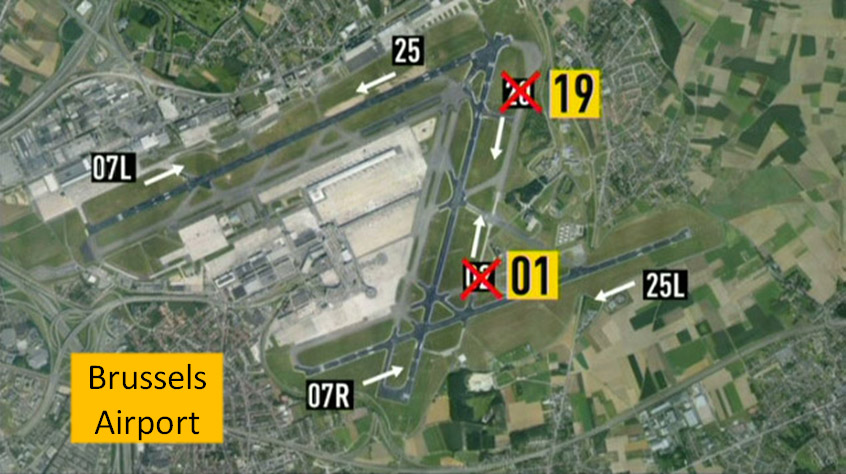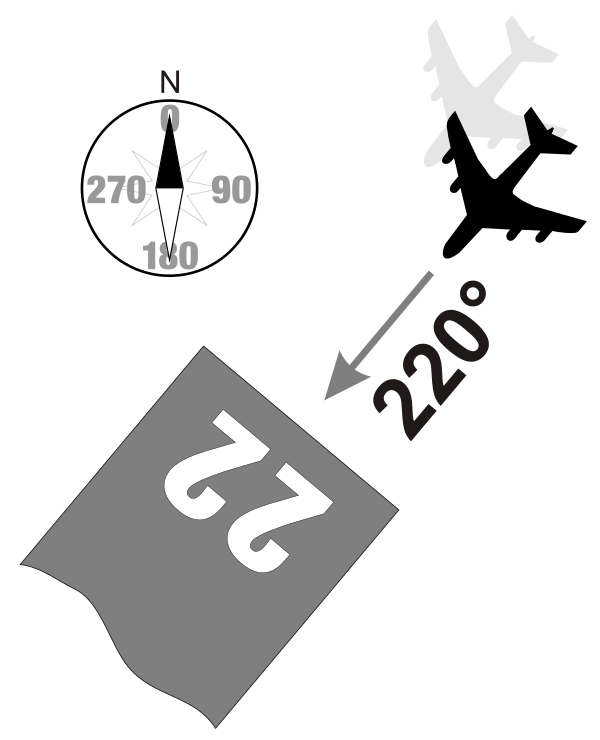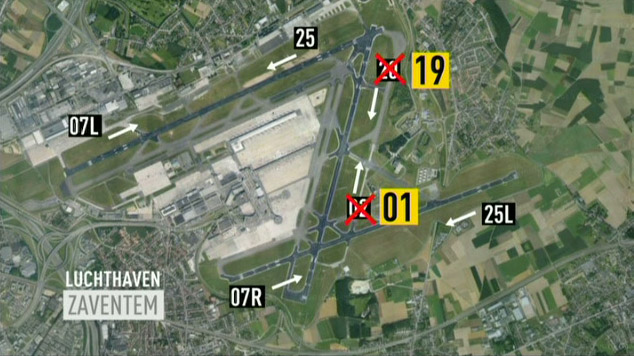PROG0400 - Runway
Everywhere around the world, runways on airports are numbered from 01 to 36, depending on their orientation towards the compass: number 09 stands for the East (90°), 18 for the South (180°), 27 for the West (270°) and 36 for the North (360°). Because runways can be used in 2 directions (that differ by 180°), they receive two numbers that always differ by 18. That explains why runway 02 also is runway 20 in the opposite direction an why runway 07 is also runway 25.
The compass points to the magnetic north, the location of which is not entirely stable. The magnetic north of our planet moves a little every year, which results in 11 degrees becoming 10 degrees and a couple of years later, 10 will turn into 9 degrees. This is why airports end up having runways of which the number no longer corresponds with the reality of the compass. Although the yearly moving is not that big, Brussels Airport had to rename its 02/20 runway in 2013. It is now called runway 01/19. The change of name became official in the night of 18 September. Although this wasn't the first time for such an event to happen at a big airport, it is rather seldom and barely documented. The other two, parallel runways at Brussels Airport already got a new name in the early 1970's. The runway that was until then known as 08/26, was from that moment on called 07/25. However, it looks like it will receive yet another new name in a couple of years: 06/24.
Assignment
Every runway of an airport is appointed an integer between 01 and 36 (boundaries included), which is equal to one tenth of the angel between the direction of the runway and the magnetic North. These numbers are rounded off to the closest natural number. This means for example, that all runways for which the angle is situated in the interval [215°, 225°[ , are indicated with the number 22. Also, a runway is never indicated with the number 00, because number 36 is preferred.
Depending on the wind direction, a runway is flown to from one of both directions. Therefore, a runway is indicated with two numbers instead of one. The runway that is indicated with number 33 in one direction, is equal to runway 15 if it is flown to from the opposite direction. The difference between both numbers is always 18 (180°). The indication of a runway consists of 2 numbers that are separated by a slash: dd/dd. Every number consists of two digits (numbers that are smaller than ten receive a 0 in front). The first number is always smaller than the second number.
Input
A number $\alpha \in \mathbb{R}$ that represents the angle (in degrees) between one of the flying directions of a runway and the direction that points to the magnetic north. $0 \leq \alpha < 360$ always counts.
Output
The indication of the runway in the format dd/dd.
Example
Input:
224.57
Output:
04/22
Overal ter wereld dragen start- en landingsbanen op een vliegveld een nummer van 01 tot 36, afhankelijk van hun oriëntatie ten opzichte van het kompas: het nummer 09 staat voor het oosten (90°), 18 voor het zuiden (180°), 27 voor het westen (270°) en 36 voor het noorden (360°). Omdat start- en landingsbanen in twee richtingen kunnen gebruikt worden (die ten opzichte van elkaar 180° verschillen) krijgen ze twee nummers waarvan het verschil altijd 18 is. Dat verklaart waarom baan 02 ook baan 20 is maar dan in de tegenovergestelde richting en waarom baan 07 ook baan 25 is.
Het kompas richt zich naar het magnetische noorden, maar de locatie daarvan is niet helemaal stabiel. Het magnetische noorden van onze planeet verschuift elk jaar een beetje, waardoor 11 graden op een bepaald moment 10 graden worden en een paar jaar later dan weer 9 graden. Zo komt het dat luchthavens na verloop van tijd een startbaan hebben waarvan het nummer niet langer klopt met de realiteit van het kompas. Hoewel de jaarlijkse verschuiving niet zo groot is, heeft Brussels Airport in 2013 het punt bereikt dat baan 02/20 omgedoopt moest worden tot baan 01/19. Deze naamswijziging werd officieel in de nacht van 18 op 19 september 2013. Hoewel het niet de eerste keer is dat zoiets op een grote luchthaven gebeurt, is dit toch eerder zeldzaam en weinig gedocumenteerd. De twee overige — parallelle — start- en landingsbanen op Brussels Airport kregen in de vroege jaren 1970 als nieuwe naam 07/25. Tot dan werden ze aangeduid als baan 08/26. Het ziet er echter nu al naar uit dat dit over een paar jaar opnieuw zal moeten gewijzigd worden naar 06/24.
Opgave
Elke start- en landingsbaan op een luchthaven wordt aangeduid met een natuurlijk getal tussen 01 en 36 (grenzen inbegrepen) dat gelijk is aan één tiende van de hoek tussen de richting van de baan en het magnetische noorden. Hierbij wordt afronding gebruikt naar het dichtbijzijnde natuurlijk getal. Dat betekent bijvoorbeeld dat alle banen waarvoor de hoek in het interval [215°, 225°[ ligt, aangeduid worden met het getal 22. Een baan wordt ook nooit aangeduid met het getal 00, omdat voorkeur gegeven wordt aan het getal 36.
Afhankelijk van de windrichting wordt een start- en landingsbaan in één van beide richtingen aangevlogen. Daardoor wordt een baan niet aangeduid met één enkel getal, maar met twee getallen. De baan met aanduiding 33 in één richting is immers gelijk aan de baan met aanduiding 15 als ze in de andere richting aangevlogen wordt. Het verschil tussen beide getallen is altijd gelijk aan 18 (180°). De aanduiding van een landingsbaan bestaat dus uit twee getallen gescheiden door een slash: dd/dd. Elk getal wordt hierbij genoteerd met twee cijfers (getallen kleiner dan tien worden genoteerd met een voorloopnul). Het eerste getal is ook telkens kleiner dan het tweede getal.
Invoer
Een getal $\alpha \in \mathbb{R}$ dat de hoek (in graden) voorstelt tussen één van de aanvliegrichtingen van een landingsbaan en de richting die wijst naar het magnetische noorden. Er geldt steeds dat $0 \leq \alpha < 360$.
Uitvoer
De aanduiding van de landingsbaan in het formaat dd/dd.
Voorbeeld
Invoer:
224.57
Uitvoer:
04/22
| Added by: | Peter Dawyndt |
| Date: | 2013-06-05 |
| Time limit: | 10s |
| Source limit: | 50000B |
| Memory limit: | 1536MB |
| Cluster: | Cube (Intel G860) |
| Languages: | PY_NBC |
| Resource: | None |




 RSS
RSS